Door Security
Introduction
Having allowed us access to our home or a room within it, it’s nice to be able to close a door behind us for some privacy and indeed lock others out. This is where latches and locks come in…
Door security is only as strong as the weakest element, so before selecting a lock ensure that the door itself and its frame are up to the job. Similarly, an intruder will choose the route of least resistance, so ensure all your external doors are suitably secured.
All door locks include a bolt that prevents the door from being opened by extending from the lock into the ‘strike’ which is mounted in the doorframe. The type of bolt used has a great effect on the overall strength of the lock, and there are two different types;
Differences between locks
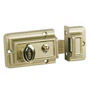
A latchbolt is bevelled and sprung so that it extends into the strike plate by up to 12mm (½in). Turning a knob or handle compresses the spring and draws the bolt back so that the door can be opened.
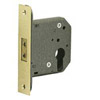
A deadbolt is rectangular and is not spring-loaded; instead the bolt is extended or retracted by turning a key.
The bolt is large in section and sits in the strike plate by up to 25mm (1in), making it more robust than a latchbolt. In addition, where a latchbolt can be pushed back with a credit card, a deadbolt cannot and is therefore more secure.

The strike plate, that comes with every door lock to accept the bolt in the frame, can add strength to the assembly or can simply be for cosmetic purposes. Those made of heavy gauge metal and fitted with long 75mm (3in) screws that reach into the wall frame, not just the door jam are the most secure. Even further strength is gained where the screws are staggered so they don’t penetrate the same grain of wood.
Mortice Locks
- The word mortice is a carpentry term that describes a hole cut into timber as part of a joint, and this is used to describe these locks since they sit in such a hole, cut into the latch stile of a door.
- Home insurance companies, and the police, recommend that exterior doors are fitted with a 5-lever mortice deadlock which carries the British Standard 3621:1980 kitemark. This means that the lock is resistant to picking, drilling, cutting and forcing and has at least 1000 key variations.

A mortice deadlock is totally hidden in the door as it does not have handles. The deadbolt is operated by a key through a keyhole which is the only visible part of this type of lock. With no latch, however, these locks do not keep a door closed unless they are set to the locked position, so they are usually coupled with a latched cylinder lock.
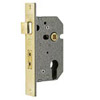
Alternatively a mortice sashlock, which includes both a deadbolt and a latchbolt, can be used if a handle is to be mounted on the face of the door. The deadbolt provides locking security, while the spring-mounted sashbolt keeps the door closed in it’s frame. Be careful to select a mortice sashlock that is suitable for your left- or right-opening door.
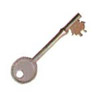
Mortice locks are available with anything from 2 up to 7 levers, and the more levers there are, the harder it is for the lock to be picked. Each lever is a flat, brass spring loaded plate that has a small unique notch in it. The key that works in each lock is cut with complementary notches to each of the levers so that it can lift and align them, allowing the deadbolt to pass through them.
Cylinder Rim Locks
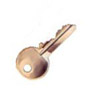
These surface mounted locks penetrate through a door, with a keyhole mounted on the exterior and a handle on the interior. They all work with a bevelled deadbolt that projects into a frame-mounted staple to lock the door when it is closed, and can only be re-opened by the key or the handle.
- Traditional versions of these locks, sometimes called ‘nightlatches’, do not provide good security as they are too easily forced open and cannot be double locked. This means that having gained access to your property, an intruder can simply let himself out of the front door.
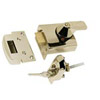
Modern upgraded models can be double locked with a turn of the key from the outside so that even the handle inside cannot release the door. Some versions also have a keyhole on the inside so this lock can be engaged even when you’re at home. Be careful to leave the key in the hole however, so that you may exit quickly in the event of a fire.
Other Door Security
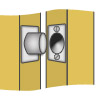
Hinge bolts help to prevent hinged doors from being broken from their frames. These should particularly be added to external doors that open outwards, such as French doors, where the knuckles of the door hinges could be sawn off by an intruder.
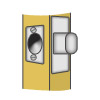
Mortice rack bolts use standardised keys to drive deadbolts into the doorframe. These can be added to any hinged door for extra security.
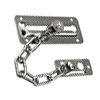
Door chains are excellent for giving you piece of mind when answering the door to strangers. The chain allows the door to be opened sufficiently to hold a conversation, but prevents any intruder from forcing the door in.
Further information and useful links
- How to fit a mortice lock
- Introduction to doors
- Introduction to painting doors
- Full list of windows & doors topics
- Find a Door Furniture supplier near you
- Find a Door Security supplier near you
Site Pages
Featured Articles





